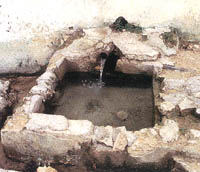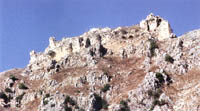|
To go to Nabatiye, drive from Sidon to Zahrani,
Msayleh, Zefta, Dayr Zahrani, and Habbush.
Nabatiye is the most important town of the Jabal Amel
area and the chief center of both the mohafazat and the caza.
Nabatiye enjoys an important economic and cultural
positoin.
Every Monday
is market day and traders and visitors from neighboring
villages gather in the city center to exchange their goods.
In Nabatiye are branches of several banks, hospitals,
restaurants and cultural and touristic clubs, like the al Shqif
Club. Every year
Nabatiye commemorates the Battle of Karbala to remember the
martyrdom of Iman al Husayn. On
this occasion, tens of thousands of visitors, mainly of the
Shiite community, come to participate in this religious
ceremony.
|
|

Spring in Jbaa

Beaufort
Castle
|
|
Nabatiye is
the hometown of several learned men of international reknown.
The theologian, sheikh Aref al Zein, and the scientist,
Kamal al Sabbah, are among the most famous.
Nabatiye has two historic mosques: the first one was
built in the 16th century and lies in the town
center; and the second one, known as “the Mosque of the
Prophet,” dates to the Mamluk period and is located in
Nabatiye al Fawqa.
Arnun lies 7
km south-east of Nabatiye. On
top of a hill overlooking the southern Beqaa to Damascus
stands a fortress known to Arab travellers as Shqif Arnun,
Shqif being a Syriac term meaning high rock.
Western travellers call it Belfort or Beaufort.
At first sight, it seems inaccessible, but it can be
easily reached from the village of Arnun. In front of the fortress the visitor will see a large water
cistern and the ruins of an ancient village contemporary with
the citadel. There is
no direct evidence of the building date or the builder of this
castle. According to
William of Tyre, it was erected by the Crusaders, but some
scholars are of the opinion that it is older.
It has been suggested that the monument was already
standing when the Crusaders arrived.
It has also been argued that it was first built in the
Late Roman or Byzantine period, later restored and enlarged by
the Arabs. The
Crusaders restructured and fortified it and it became the
important fortress in Lebanon.
The Crusader king, Foulques d’Anjou, conquered it
from the ruler of Damascus and gave it to the Crusader rulers
of Sidon in 1138. Salaheddin
besieged it for two years and was able to storm it in 1140.
The Crusader regained control of the citadel in 1190
after they had signed an agreement with Al Salih Ismail, ruler
of Damascus. In 1260,
it was bought by the templars from the Sidonian prince and it
remained their property until its conquest in 1268 by the
Mamluk Sultan, Al Zahir Baybars.
The Templars built there a small fort called Chteau
Neuf. Fakhreddin
restored and fortified it at the beginning of the 17th
century, but the governor of Damascus, Hafez Pasha, besieged
it and partly destroyed it with his artillery.
The restoration of the monument was initiated by the Lebanese
Directorate of Antiquities in the late 1970’s but it soon
had to stop because of repeated Israeli bombardments.
The Crusader castle has been under Israeli occupation
since 1982. The
fortress lies on a 700 meters high rocky mound.
Its plan had to follow the relief and topography of the
site and resulted in a quasi-rectangular shape.
To the east, it overlooks the 300m deep Litani River
valley. On the other
three sides, it is surrounded by a moat.
In spite of its very bad state of preservation, some of
its elements are sill standing and easy to identify.
On both ends of its well-preserved southern wall rise
two beautiful towers. The
wall is built on top of a glacis covered with flat stones and
covering all the rocky platform on which the fort stands.
The monument originally had three stories, but the
third one has been totally destroyed.
The main
entrance leads to the ground floor and is located on the
eastern side of the building. It
is protected by three towers, on top of which a large number
of fighters could stand. In
the south-eastern corner is a second entrance leading to the
upper floor and, finally, a third entrance in the
south-western angle surmounted by machicolations leads to the
center of the main courtyard. Inside,
the castle is almost completely ruined and only the eastern
wall, entrance and staircase of a big tower in the middle of
the western side survive. On the eastern side is a 13th century vaulted building,
either a church or an assembly hall.
On the northern side are the remains of two towers and
of a large cistern which occupies part of the moat surrounding
the fortress |





